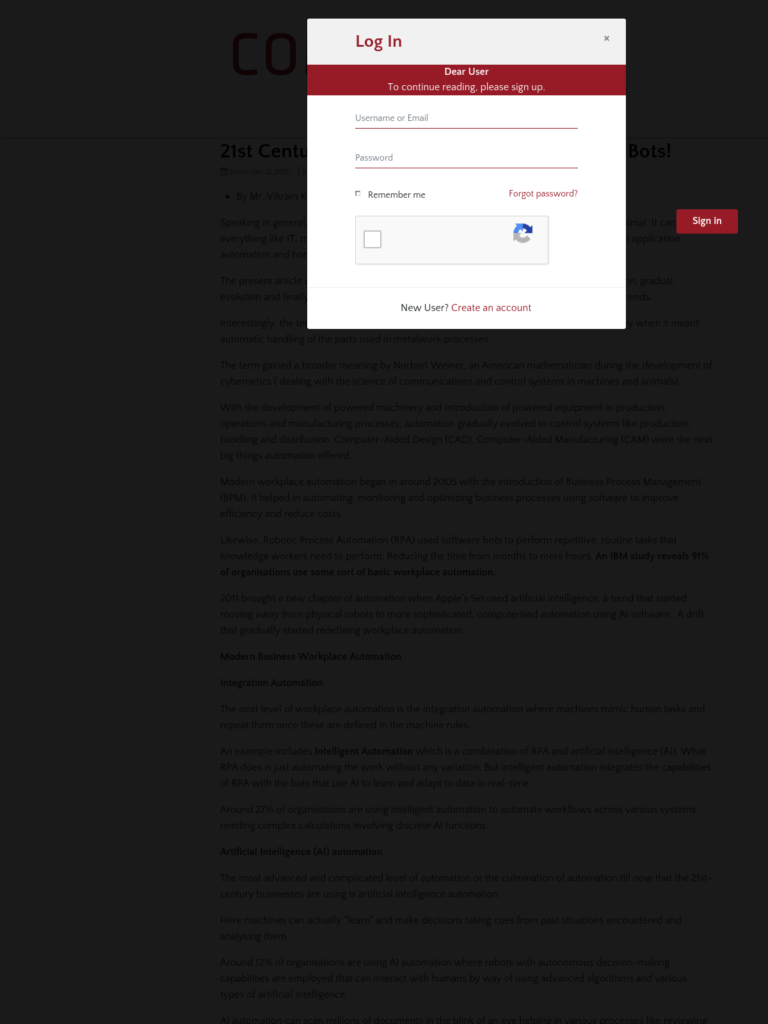21st Century Workplace Automation : Beyond Bots!
Blog: NASSCOM Official Blog
- By Mr. Vikram Kumar, Co-Founder and Managing Director, SRV Media Pvt. Ltd
Speaking in general, automation is the use of technology where human involvement is at minimal. It can include everything like IT, marketing, business process, industrial and even covers areas like personal application automation and home automation.
The present article will focus basically on workplace automation while touching upon its origin, gradual evolution and finally exploring the workplace automation in the 21st Century and the future trends.
Interestingly, the term automation has its origin way back in 1940 at the Ford Motor Company when it meant automatic handling of the parts used in metalwork processes.
The term gained a broader meaning by Norbert Weiner, an American mathematician during the development of cybernetics ( dealing with the science of communications and control systems in machines and animals).
With the development of powered machinery and introduction of powered equipment in production, operations and manufacturing processes, automation gradually evolved to control systems like production, handling and distribution. Computer-Aided Design (CAD), Computer-Aided Manufacturing (CAM) were the next big things automation offered.
Modern workplace automation began in around 2005 with the introduction of Business Process Management (BPM). It helped in automating, monitoring and optimizing business processes using software to improve efficiency and reduce costs.
Likewise, Robotic Process Automation (RPA) used software bots to perform repetitive, routine tasks that knowledge workers need to perform. Reducing the time from months to mere hours. An IBM study reveals 91% of organisations use some sort of basic workplace automation.
2011 brought a new chapter of automation when Apple’s Siri used artificial intelligence, a trend that started moving away from physical robots to more sophisticated, computerised automation using AI software. A drift that gradually started redefining workplace automation.
Modern Business Workplace Automation
Integration Automation
The next level of workplace automation is the integration automation where machines mimic human tasks and repeat them once these are defined in the machine rules.
An example includes Intelligent Automation which is a combination of RPA and artificial intelligence (AI). What RPA does is just automating the work without any variation. But intelligent automation integrates the capabilities of RPA with the bots that use AI to learn and adapt to data in real-time.
Around 27% of organisations are using intelligent automation to automate workflows across various systems needing complex calculations involving discrete AI functions.
Artificial Intelligence (AI) automation
The most advanced and complicated level of automation or the culmination of automation till now that the 21st-century businesses are using is artificial intelligence automation.
Here machines can actually “learn” and make decisions taking cues from past situations encountered and analysing them.
Around 12% of organisations are using AI automation where robots with autonomous decision-making capabilities are employed that can interact with humans by way of using advanced algorithms and various types of artificial intelligence.
AI automation can scan millions of documents in the blink of an eye helping in various processes like reviewing legal contracts, giving medical treatment suggestions, claims analysis and much more.
Companies use AI intelligence to personalise customer experiences, improve business decision making and forecasting.
Future Trends
Evolvement of new software along with RPA will help machines to observe better, learn from human patterns and optimise them.
Machine learning is definitely going to revolutionize work and the workplace, both. Some forecasted trends could be:
Hyperautomation
Hyperautomation is a term used to describe the merging of machine learning, software and automation tools to maximize automation processes in the workplace to augment productivity fast.
By combining a range of cognitive processes with automation technologies it will deliver intelligence and power both and the power to convert intelligence into action.
Minimal or No-Code Workflow Software
Workflow software will require minimal coding to make the process automation more accessible to the entire organisation
Intelligent & Augmented Capabilities
AI-based systems will remember, reason and predict, leading to improved ability to learn and interact.
While these are just a few possible trends, more could be in the offing just waiting for the time to unfold.
The post 21st Century Workplace Automation : Beyond Bots! appeared first on NASSCOM Community |The Official Community of Indian IT Industry.
Leave a Comment
You must be logged in to post a comment.








